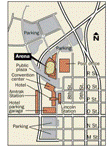Community and Regional Planning Program

Community and Regional Planning Program: Faculty Scholarly and Creative Activity
Document Type
Article
Date of this Version
2018
Citation
Published in Natural Hazards 94 (2018), pp 777–800.
doi:10.1007/s11069-018-3420-y
Abstract
The increasing occurrence of extreme weather and climate events raised concerns in regard to hazard mitigation and climate adaptation. Local municipal planning mechanisms play a fundamental role in increasing a community’s capacity toward long-term resiliency. This study employs the content analysis method to evaluate the 95 selected cities located in the US Federal Emergency Management Agency Region VII and examine how these local plans, including local comprehensive plans (CPs), hazard mitigation plans (HMPs), and local emergency operations plans (EOPs), prepare communities for climate change and possible extreme events. Results indicate that local plans delineated multiple resources and diverse strategies to reduce community climatic risks, where HMPs have medium-level preparation, and CPs and EOPs have limited level preparation. Local HMPs lead in mitigating for impacts from potential extreme events, but both local CPs and EOPs are proactively adapted for climatic risks. Common strengths and weaknesses exist between different planning mechanisms. Large variations exist among plans due to varying jurisdictions among cities. However, the plans score similarly overall—higher on strategies and factual base but are short of clear and detailed goals, objectives, and agendas. Finally, despite the diverse vertical and horizontal outreach, there is inadequate integration among local planning mechanisms to share climate hazard information.
Included in
Emergency and Disaster Management Commons, Urban, Community and Regional Planning Commons


Comments
Copyright © 2018 Springer Nature B.V. Used by permission.